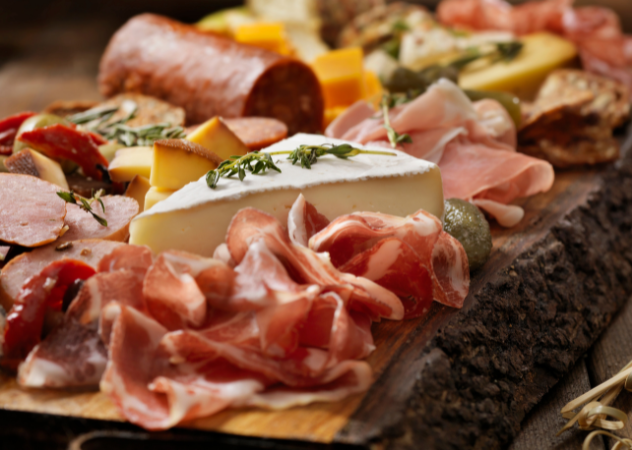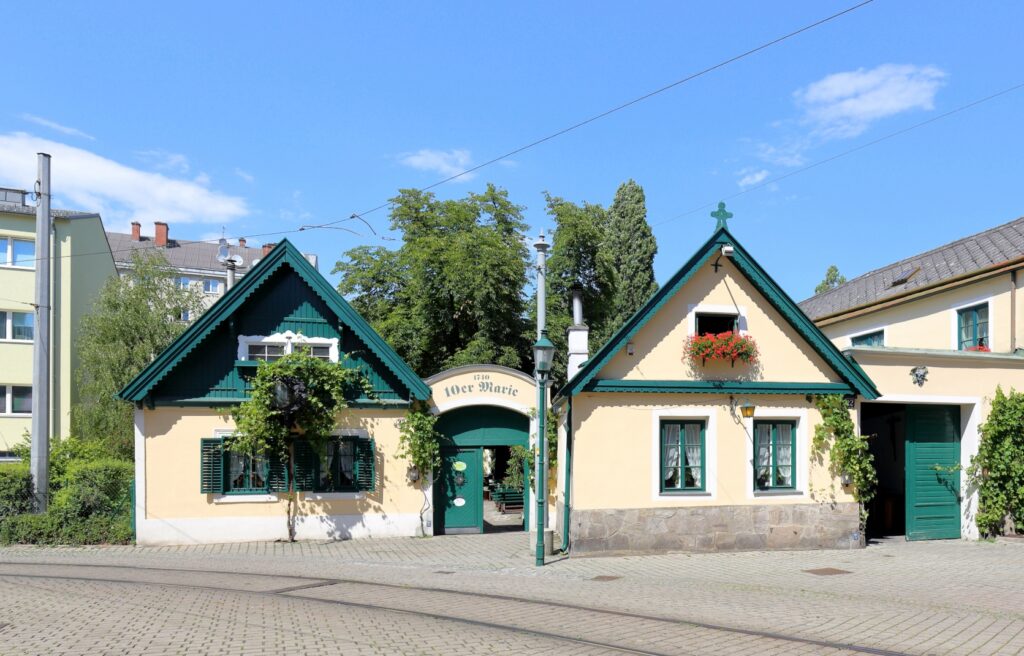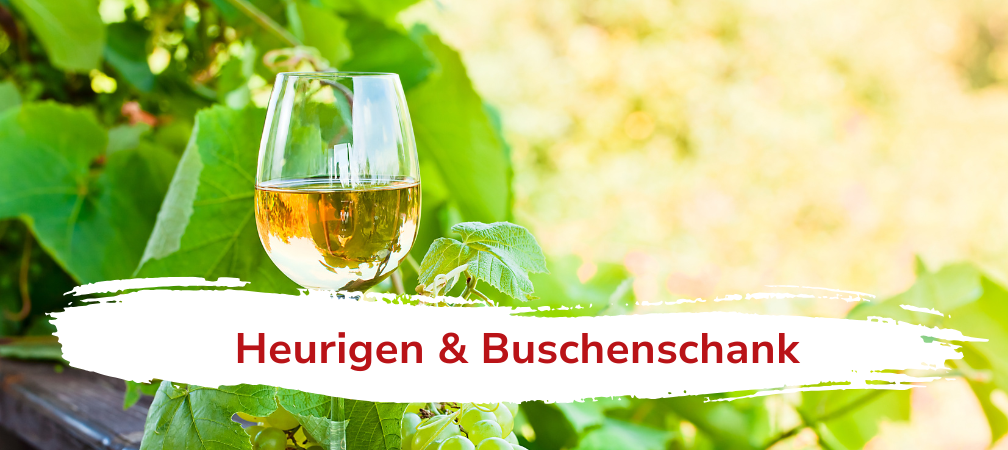Your guide to Austria’s much-loved wine taverns
The irresistible smell of fresh bread, a glass of crisp white wine in your hand, animated conversations under chestnut trees – a visit to Austria’s wine taverns is not just your regular lunch or dinner, but a visit steeped in tradition. So what exactly makes Heurigen and Buschenschank so special, why are they such an integral part of Austrian culture (especially in the East), and how do they actually compare?
What is the difference between a Buschenschank and a Heuriger?
Before we dive into the details, it’s worth taking a closer look at both terms and their basic meaning, which already is a great indicator of where the differences are. The word “Heuriger” is derived from the Austrian word “heuer”, which means “this year” – and refers to the wine that is served there, namely wine with the current vintage. The so-called Buschenschank, on the other hand, owes its name to the “Buschen” – a bundle typically made of fir branches, and traditionally hung above the entrance to indicate that guests are welcome, and that there’s wine and food available. Perhaps surprisingly, this custom dates back to the Middle Ages, with the display of brushwood mentioned in a Vienna city ordinance as early as 1459.
Now, let’s take a closer look at the actual definitions and differences:
- Type of business: A Buschenschank typically only offers their own products, i.e. food and drink that have been produced by the business. A Heuriger, on the other hand, is your classic restaurant or caterer – here, you may be able to try home-made wine, but also wine from other wineries or food and drink sourced from other businesses and wholesalers. The only mandatory item on the menu is probably obvious: Wine from the current vintage.
- Food: A Buschenschank only serves cold dishes and snacks, while a Heurigen typically offers both cold and hot treats.
- Opening hours: The Buschenschank is only open during the season, for a limited time only. The Heurigen, on the other hand, is generally open all year round.
- Legalities: The term “Buschenschank” is protected by law, while Heurigen is not subject to any such regulations.
Despite these official definitions, the lines are much less clearly drawn in reality. The more important aspect is regionality: “Heurige” are mainly found in Vienna and Lower Austria, while Buschenschanken are typically associated with Burgenland and Styria.
There are currently around 100 Heurigen in Vienna alone, with many more dotted across all other federal states. For winegrowers, they are the perfect way to present and sell their wines directly to the customer – which also goes a long way in boosting the local economy. Whether groups passing through, hungry cyclists or locals in search of culinary delights and great company: The local wine taverns firmly remain the first point of call.
What food and drinks are available at Heurigen & Buschenschank?

The food and drinks are also quite similar in most wine taverns and are characterised by regional flavours: You will usually find fresh pastries, s a n d w i c h e s , sausage, meat, cheese and spread platters and, of course, a variety of drinks on the menu. From white or red grape juice to wine – often home-made– and seasonal specialities such as Sturm: there is something for everyone. To reflect customer demands, vegetarian dishes and options for allergy sufferers are now also commonly found on the menu.
Speaking of which: The first glance at the menu is often confusing, especially for tourists from abroad. Because in keeping with tradition, the names for food and drink are almost always written in Austrian German. To help you find your way, we’ve put together a list of the most common terms below. And remember: It’s perfectly acceptable to ask your waiter or host for recommendations!
- Spritzer: Usually a dry white wine topped up with soda water
- Kaiserspritzer: A Spritzer finished with a dash of elderberry syrup
- Sommerspritzer: Literally translates to “Summer Spritz” – a spritzer containing less alcohol and more soda water.
- Sturm: A partially fermented grape juice, usually available in autumn.
- Most: refers to either grape juice, fruit wine or fruit juice made from apples or pears – depending on the region
- g’spritzt: If you order a drink “g’spritzt”, it will be diluted with soda water
- Köllagatsch: “Kellergatsch”, literally translating to “basement mud” – a spread made from sausages, onions, peppers and cucumbers.
- Liptauer: A cheese spread made from curd cheese with butter or cream, and seasoned with ingredients like paprika, onion and caraway seeds.
- Erdäpfelkas: literally translates to “potato cheese” – a creamy spread made from potatoes, onions and spices.
- Vahockats: “minced meat” – a spread made from finely chopped bacon mixed with a bit of lard
- Grammeln/Grieben: crispy pieces of bacon which are left over when heating pork fat
- Gsöchts: “Geselchtes” – hot-smoked pork meat
- Blunzn: Blood sausage (fun fact: this can also be used as an insult)
- Beuschel: A ragout of lungs and heart, often served with bread dumplings
- Feuerfleck: literally “fire patch” – a slice of flatbread, traditionally topped with a garlic cream spread.
| Tip: Make sure to check out our article on Austrian dialects to discover even more Austrian terms and linguistic peculiarities from East to West. And if you’d like to learn more about life and culture in Austria, or improve your German language skills, we’ve got a wide variety of German courses to suit every language level to choose from, from A1 to C2 – including individual courses, group courses, and specialized German courses for companies. |
What else to expect at a Heurigen & Buschenschank
If you’re looking for a cosy atmosphere and regional specialities, Austria’s wine taverns are the perfect place to start – whether you’re enjoying great food and drinks under the trees, in arbours covered in vines, or with sweeping views of expansive vineyards.
However, these classic institutions are not the only option for those looking to quench their thirst: In fact, wine taverns have pretty much been around since the Middle Ages. And the concept of a hearty meal enjoyed in the countryside has remained relevant until today, even though the culinary treats on offer have naturally changed and expanded in keeping with the times. That’s why you’ll find both rustic wine taverns firmly embracing classic Austrian décor, as well as more contemporary and modern interpretations. For example, you might come across the most traditional, centuries-old tavern serving responsibly sourced organic wine and vegetarian options, or find regional home cooking in modern eateries. Either way: Tradition lives on in both. And so, in many places today, you’ll still find those little bushes hanging over the doors to welcome guests – even if a quick search on the internet has already revealed the opening hours.

Music is another important aspect in many traditional taverns, a custom that can be traced back all the way to late 19th century Vienna when the two Schrammel brothers joined forces with two other musicians to form a band called the “Nußdorfer”, who then soon became known as the “Schrammel Quartet“. With two violins, a guitar and a clarinet (later replaced by an accordion), they performed for famous composers as well as the aristocracy, and even at the World’s Fair in Chicago. However, they owed their initial success to their performances in wine taverns outside the city – which instantly made the melancholic-yet-cheerful Schrammel music a symbol of Viennese Heurigen culture.
The ABC of Heurigen: The best tips for connoisseurs
You’re planning your first visit to a wine tavern or Buschenschank and are wondering what to expect? No need to worry: With these practical tips, you’re guaranteed to make your first ever visit a resounding success:
- Bookings: Heurigen and Buschenschank are usually open in summer and early autumn, and usually busy. While it’s common for small groups to simply pop in and grab a table, it’s best to book in advance for larger groups to make sure you’ll get a seat.
- Greetings: Especially in small restaurants, it’s considered good manners to briefly greet the waiter and other guests you’re passing on your way to the table. This common courtesy is as much a part of the Heurigen culture as grape juice and wine.
- Type of service: Once you’ve found a table, you need to figure out whether it’s self-service or table service. More often than not, you’ll have to order at the “Schank” – the bar. However, if there is table service, waiters are usually already there to welcome new guests, armed with menus and wine recommendations.
- Payment: There is one simple rule: Everything you order at the bar must be paid immediately, whereas if you’ve ordered food and drinks at the table, you’ll pay for everything at the end of your meal. An excessively large tip is not usually expected, but it’s all the same considered polite to round up the total by a few euros.
If our write-up has whetted your appetite for regional specialities and a cosy visit to Austria’s traditional wine taverns, you can simply take a quick look at an online “Heuriger” calendar to find a Heurigen or Buschenschank near you. If you’d like to keep things old school, you can also just keep an eye out for that tell-tale bundle of twigs while hiking or cycling.

Want to find out more about the life, people and language in Austria? Then make sure you check out our blog which is packed full with useful reading material – from our guide to Austrian cuisine and Viennese coffee specialities to our best tips for learning German. Happy reading!

